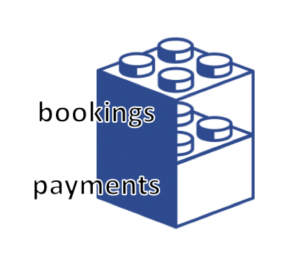The top 5 reasons you should be using APIs
I’ll start this post with a quote from Jurassic Park the movie: “The world has just changed so radically, and we’re all running to catch up.”
This comes to my mind whenever I think of technology. Everything is always changing, evolving, and updating, and everyone is trying so hard to fit in. There’s a constant demand for businesses to not only have a website and mobile app but also introduce Artificial Intelligence or Machine Learning, support Big Data, and the list goes on.
In my previous posts, Introduction to APIs – Part 1 and Part 2, I explain what an API is and why it’s important for your business. Today, I’ll summarize the top five reasons you should be using APIs if you want to stay relevant and competitive in this evolving world.
1. Reusability
I always say that APIs are like building blocks. You take one piece and connect it to the other.
Let’s say you want your system to be able to book a flight, and then let the user input their payment information in order to confirm the transaction. For this case, you’d need two APIs: the bookings API and the payments API. The bookings API will handle the booking creation, booking update, and booking cancellation. The payments API will take care of anything payment-related, like handling credit and debit card payments, performing refunds, etc.
You notice that you’d be able to grow your business by also offering car rentals to your clients. You would assume that it would take the same amount of time to create this new API, right? Well, you’ll need a new API to show the cars that are available, let the user choose the car they want, and pay for the rental.
But, guess what? You already have a payments API that can be re-used for this scenario, so you can simply connect this API to your new car rental API! There’s no need to create a new payments API, because the existing one is not tied to any system, it simply takes care of payments, no matter where it comes from or what it’s for.
2. Do more with less
Continuing with the reusability benefits – there are a lot of public APIs that anyone can use and integrate to their system as needed. If your system is social-media related, you have Twitter’s API, Facebook’s API, Slack’s API. If you need some storage options, you can use AWS S3’s API, Google Drive’s API, Box’s API. I could list hundreds of helpful public APIs. You have the power of all these services, integrated into your own system, without having to invest more than a couple of days.
Most public APIs have documentation for developers, so they can easily understand the uses of it, and how to “connect” these building blocks. You don’t need someone who’s specialized in a particular API to get it working for you. These documents are built so that any developer can read them and be clear on what to do and how to do it.
Now, I’m sure you’re wondering, what kind of developers do I need to integrate all this? Well, sure, APIs can be consumed with almost any programming language of your choice. But guess what? There’s a company called MuleSoft that can make your life easier!
Connecting a new API with MuleSoft can be done in just a few hours. MuleSoft has a tool called Anypoint Exchange, that is somewhat of a catalogue of API connectors. These connectors are built to connect the public APIs to your system in minutes! Developers can drag-and-drop the connector they need to a flow that will act as the integration, configure a couple of fields for the API, and that’s it. You now have an integration from your system to a public API.
Here’s a very simple example of what a flow would look like:
This is using Slack’s API Connector to post a happy birthday message to the company’s office chat channel. It took less than 30 minutes to configure.
3. Community-driven
Since most APIs are public, they welcome any feedback that users have. If there’s a feature that a lot of users are asking the API creators to have, they’ll likely add it. Businesses want their API to be used as that’s the whole point of having documentation. So, if their consumers are not happy with it, they’ll stop using it, or change to a new service that offers more functionality. This is why they accept any feedback, and some of them, like MuleSoft’s Anypoint Exchange, lets developers add more features to their catalogue as well as comment and rate the connectors that are publicly available.
4. Exposure
If your API is really good, the documentation is super easy to understand, the community is actively giving feedback or developing new functionalities, your business will get a lot of exposure.
If you’re making people’s lives easier with your product, they’ll share it. They’ll start using your API, integrating it to their own systems, and telling people about it. Word travels fast when something is useful!
This is why most APIs are made public. This way anyone can use it and see for themselves if it’s something compatible with what they want to achieve. Developers can experiment on their own and learn how to use it, without the need to get involved into a paid plan, or pay for a training course.
5. “Free” or “public” is not a loss
I’m sure you’ve noticed that most businesses are starting to offer a free plan and a paid plan, either for your business needs or because you want to add more functionality. This is also the case for some APIs.
Let’s look at an example:
I personally use Postman to test my APIs. To use their API, you need to have an account. They offer both free and paid accounts. You can easily start learning or experimenting with their API with the free plan. It’s even good enough for small companies or teams.
Their API access is limited to 60 requests per minute, so, unless you have more than 60 calls going on in a minute, you’re fine with this plan. However, if you were to use this for a bigger team, and you’re constantly getting the “Rate Limit Exceeded” error, then you’d need to upgrade your account to a paid one.
I think you see what I’m getting at. You can create your public API and let the community experiment with it, gather feedback, improve, and repeat. This doesn’t mean that your business is now non-profit, or completely open source.
I hope this post opened your eyes to some of the benefits of using APIs for your business. Remember that APIs are reusable for internal or external systems, so you can choose to have private or public APIs. Having public APIs will make them discoverable for the community and will give you exposure, feedback, and tons of improvements for it to be more useful.
About the author
Made in Mexico, Alexandra enjoys learning new technologies and is always looking for new challenges. She loves statistics because she’s bad at them, so they keep her alive (an eternal challenge). Her natural habitat, however, involves watching Netflix and playing video games.





